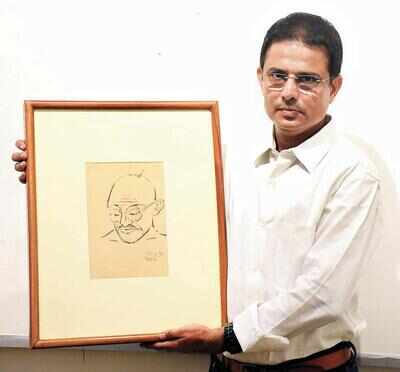- News
- City News
- vadodara News
- Dandi March sketch found in flea market to be displayed on I-day
Dandi March sketch found in flea market to be displayed on I-day

Rizwan Kadri with the rare sketch by artist Chhaganlal Jadav
Vadodara: Not many knew that a drawing book and humble pencil also joined the brigade of global lenses that snaked its way to Dandi, following the Mahatma in his historic 385km march, to defy salt laws. For, while the efforts of the battery of worlwide photographers and documentary filmmakers’ coverage of the historic event, on March 12, 1930, got instant acclaim, the 27-year-old Dalit artist, Chhaganlal Jadav’s sketches of the iconic ‘Salt March’, however, got buried in the sands of time.
These pictorial documentary was awaiting discovery at the Gurjari bazaar, amid flea market’s hidden treasures, by Rizwan Kadri, an Ahmedabad-based historian, who found the priceless ‘drawing book’.
Jadav’s sketches will now be displayed at the Baroda Museum and Picture Gallery. Starting from this Independence Day on August 15, all the 71 sketches that have been compiled and presented in form of a coffee table book, ‘Unseen Drawings of Dandi March’, will be exhibited till October 2, Mahatma Gandhi’s birth anniversary. “It will be presented in all the three languages – Gujarati, Hindi and English,” Kadri told TOI.
“This is one memoir that was never shown to the world. On March 12, 1930, Gandhiji with his 78 handpicked followers had begun the march from the ashram. Chhaganlal had joined the group and made ‘live paintings record’ of the memorable moments while moving with it. He was a member of a group called ‘Arunodaya Tukdi’ that had travelled in advance of the march and organized Bapu’s journey,” said Kadri, adding that the artist had found time to draw a few scenes and painted memorable poses of Gandhiji.
When Gandhiji was arrested in Karadi on May 5, Chhaganlal too was sentenced to three months in prison. “During these months he drew paintings and drawings of daily life in Nasik prison,” said Kadri, adding that the drawing book is thus a rare collection and a live document of the historical Dandi March.
These pictorial documentary was awaiting discovery at the Gurjari bazaar, amid flea market’s hidden treasures, by Rizwan Kadri, an Ahmedabad-based historian, who found the priceless ‘drawing book’.
Jadav’s sketches will now be displayed at the Baroda Museum and Picture Gallery. Starting from this Independence Day on August 15, all the 71 sketches that have been compiled and presented in form of a coffee table book, ‘Unseen Drawings of Dandi March’, will be exhibited till October 2, Mahatma Gandhi’s birth anniversary. “It will be presented in all the three languages – Gujarati, Hindi and English,” Kadri told TOI.
“This is one memoir that was never shown to the world. On March 12, 1930, Gandhiji with his 78 handpicked followers had begun the march from the ashram. Chhaganlal had joined the group and made ‘live paintings record’ of the memorable moments while moving with it. He was a member of a group called ‘Arunodaya Tukdi’ that had travelled in advance of the march and organized Bapu’s journey,” said Kadri, adding that the artist had found time to draw a few scenes and painted memorable poses of Gandhiji.
When Gandhiji was arrested in Karadi on May 5, Chhaganlal too was sentenced to three months in prison. “During these months he drew paintings and drawings of daily life in Nasik prison,” said Kadri, adding that the drawing book is thus a rare collection and a live document of the historical Dandi March.
FacebookTwitterLinkedinEMail
Start a Conversation
end of article
Quick Links
Delhi Air PollutionDelhi TemperatureChennai WeatherBangalore TemperatureCovid vaccination centres in DelhiCoronavirus in DelhiRTPCR test in GurgaonHyderabad RainPollution level in BangaloreDelhi SmogDelhi TemperatureNoida AQIGurgaon AQI todayFire in MumbaiMumbai RainsCovid 19 RT PCR Test in NoidaDelhi AQI todaySrinagar encounter

